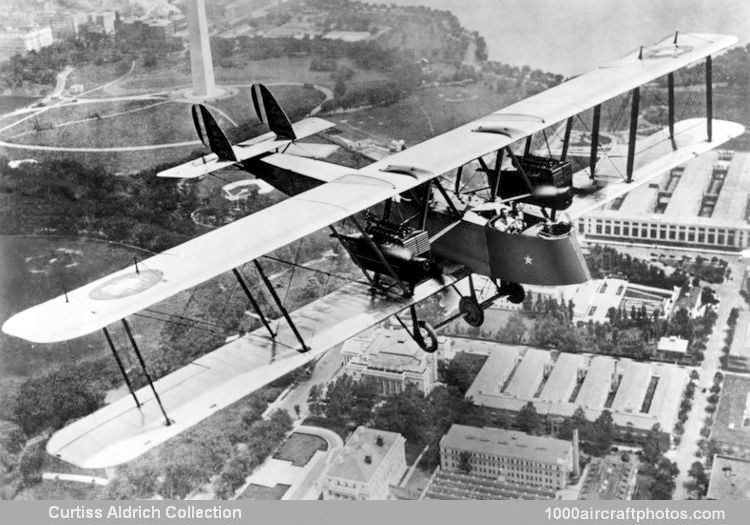01/31/2008. Remarks by Jack McKillop: "Prior to September 1919, the US Army did not have a standard designation system for aircraft and they were designated by the manufacturer's name and model number. Martin did not institute model numbers until 1922 and this aircraft became known as the Martin Bomber Number 1 (MB-1) however, the US Army officially designated it the Glenn Martin Bomber (GMB) and that is the designation used in this description.
When the US entered WW I on April 6, 1917, the US Army had a total of 55 aircraft, mostly trainers, which General John "Blackjack" Pershing, Commander of the American Expeditionary Force (AEF) in France in WW I, later said, "51 were obsolete and the other four obsolescent." As a result, the US had to rely on Britain, France and Italy to provide the US forces with aircraft.
Glenn Martin had been building aircraft in the Los Angeles, California, area since 1909. In 1916, Martin joined the Wright Brothers and formed the Wright-Martin Aircraft Company however, government action caused Wright to concentrate on building aircraft engines and Martin left the company and formed The Glenn L. Martin Aircraft Company and constructed a new plant in Cleveland, Ohio, in mid-1917. Prior to this, Martin had built a total of 97 aircraft. The factory manager of this new plant was Lawrence Bell who founded the Bell Aircraft Corp. in July 1935.
On January 17, 1918, the Aviation Section, USASC, awarded Martin a contract for a bomber with performance better than the British and Italian bombers. (The Standard Aircraft Company of Elizabeth, New Jersey, was building versions of the Handley Page H.P.12 O/400 and Carponi Ca.46 under license.) The airframe of the new Martin bomber was designed by Donald Douglas who founded The Douglas Company in July 1921 which was renamed the Douglas Aircraft Company in November 1928.
Twelve days before the Army Air Service was established, the first GMB made its maiden flight on August 15, 1918, and was tested at McCook Field, Dayton, Ohio, in September. Tests showed that it was superior to the British and Italian bombers and the Air Service ordered 50 of them for the expected offensive against Germany in 1919. After the Armistice was signed in November 1918, the order was cut back to ten aircraft which were delivered between September 1918 and September 1919.
The ten aircraft were officially designed GMB by the Army but Martin gave each a unique suffix to identify their mission. The first four were designated GMB-G, i.e., gunners, not bombers, intended for observation missions. These aircraft were equipped with five 0.30-caliber (7,62 mm) Lewis machine guns and could carry only 220 lbs (100 kgs) of bombs giving it a top speed of 118 mph (190 kmh). Three aircraft were designated GMB-M and delivered as night bombers; these aircraft were armed with three or four 0.30-caliber machine guns and could carry 1,500 lbs (680 kgs) of bombs giving them a speed of 99.8 mph (160,6 kmh).
The three remaining aircraft were delivered for special missions. Number 8, the GMB-TA, was fitted with extra fuel tanks to fly transcontinental or transatlantic flights; Number 9, the GMC, was equipped with a 37 mm cannon and a 3-inch (76 mm) recoiless rifle; and Number 10 was modified as a 12-passenger transport by removing all the military equipment, raising the top of the fuselage, adding cabin windows and seats, and enclosing the cockpit. This aircraft was initially given the Air Service designation GMP (Glenn Martin Passenger) but was redesignated T-1 in the 1919 designation system.
This aircraft was the second GMB-G built and was sent to McCook Field and assigned the number "P-88". On July 24, 1919, this aircraft took off from Bolling Field, Washington, District of Columbia, and flew around the rim of the continental US arriving back at Bolling Field on November 19, 1919. The total flight covered 9,823 mi (15,809 km) and took 108 days with a flight time of 114 hours and 25 minutes. The route was from Bolling Field to New York, New York; Augusta, Maine; Jay and Buffalo, New York; Cleveland, Ohio; Detroit, Michigan; Chicago, Illinois; Milwaukee and La Crosse, Wisconsin; Minneapolis-St. Paul, Minnesota; Fargo and Bismarck, North Dakota; Billings and Helena, Montana; Spokane and Camp Lewis, Washington (State); Medford, Oregon; Sacramento, San Francisco, Fresno, Los Angeles, San Diego and Calexico, California; Deming, New Mexico; El Paso, Fort Worth, Dallas and Houston, Texas; New Orleans, Louisiana; Montgomery, Alabama; Pinehurst, North Carolina; and back to Bolling Field.
The first two GMB-Gs and the second GMB-M were sent to the Smithsonian Institution in Washington, but none of them survived."
